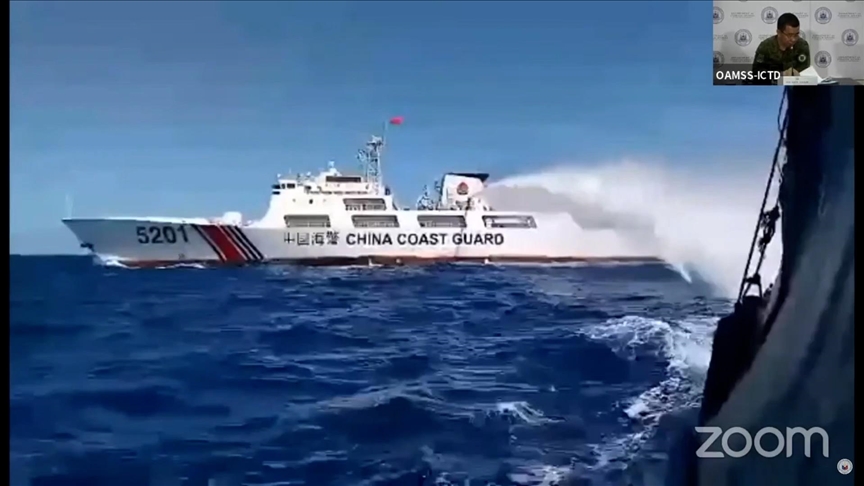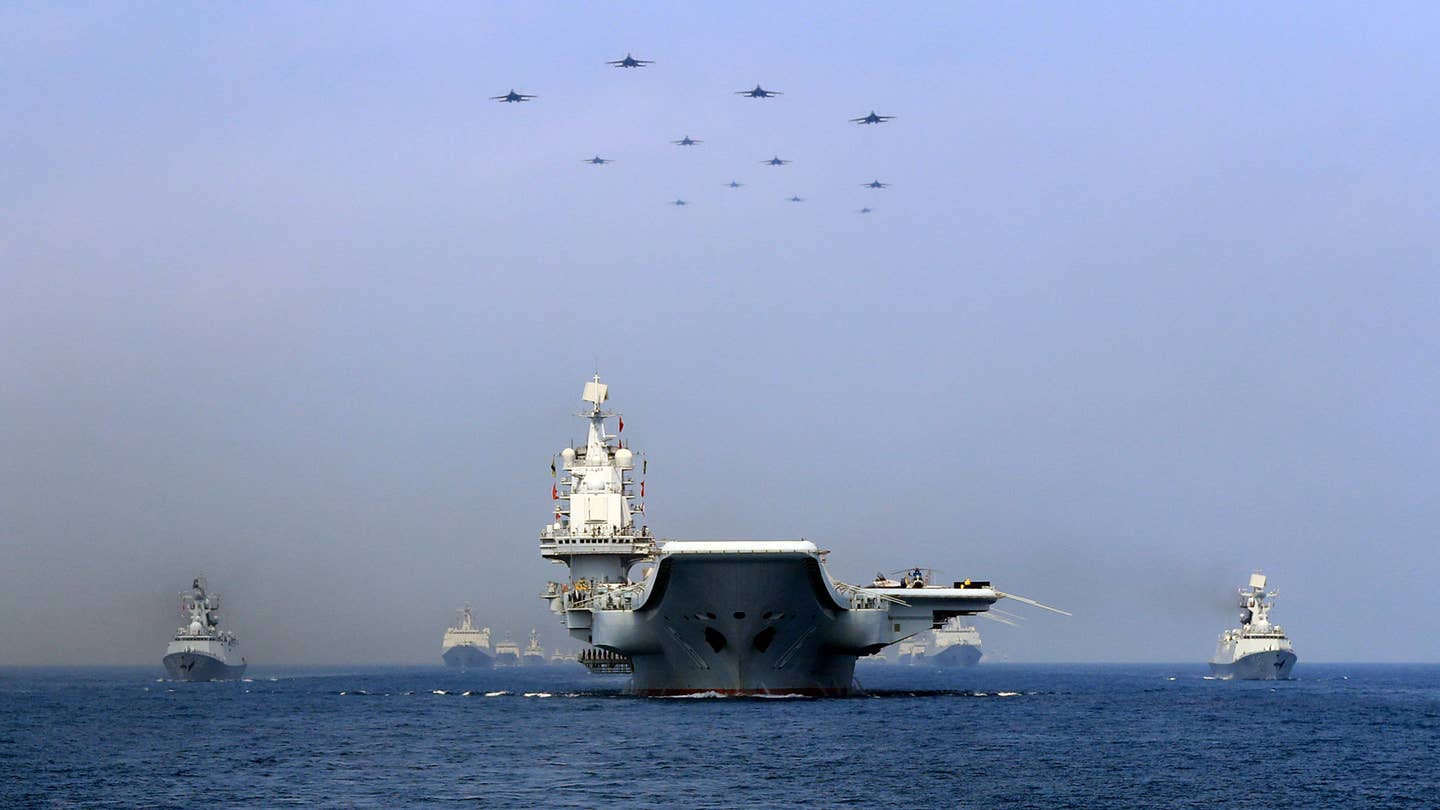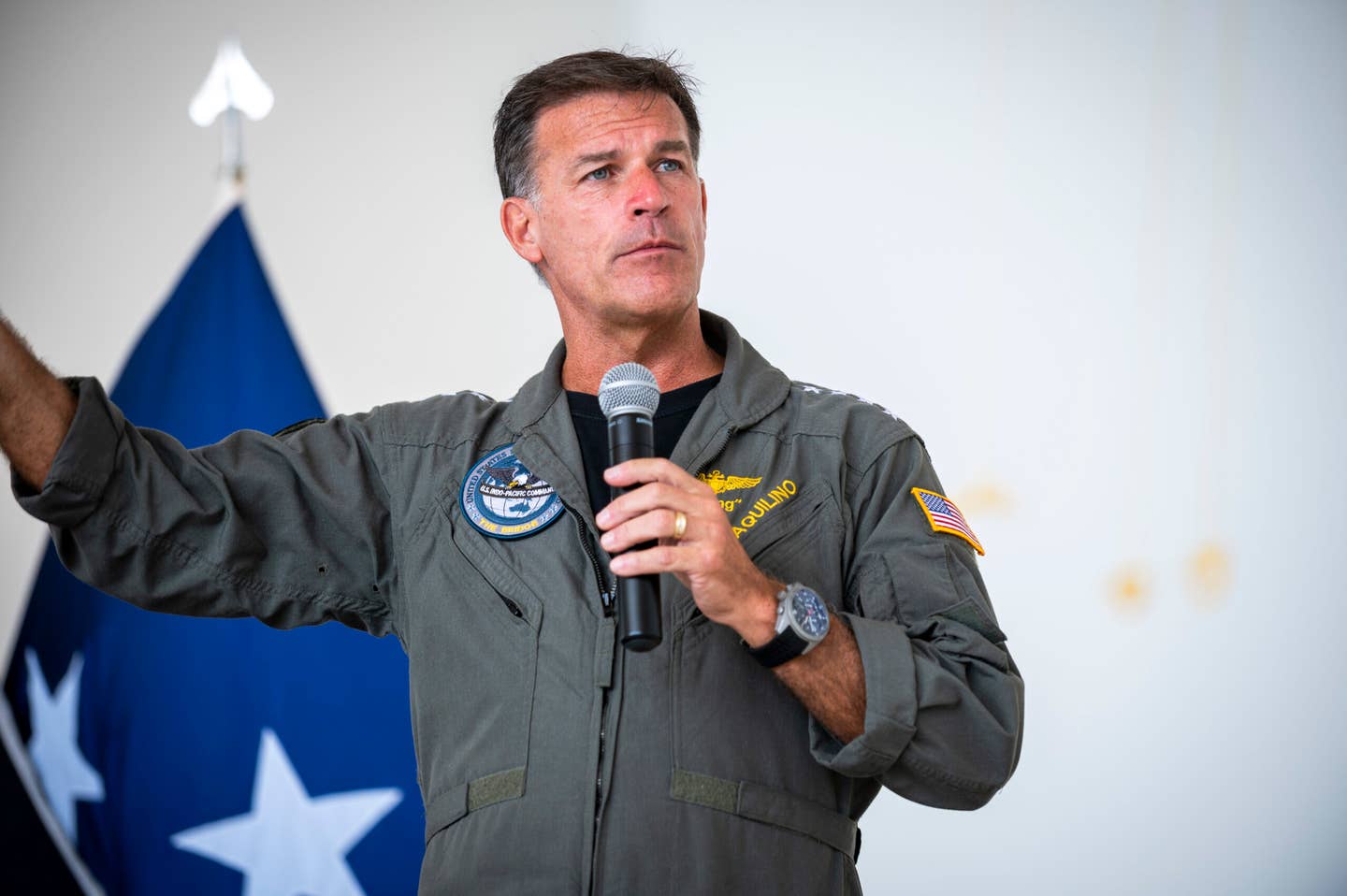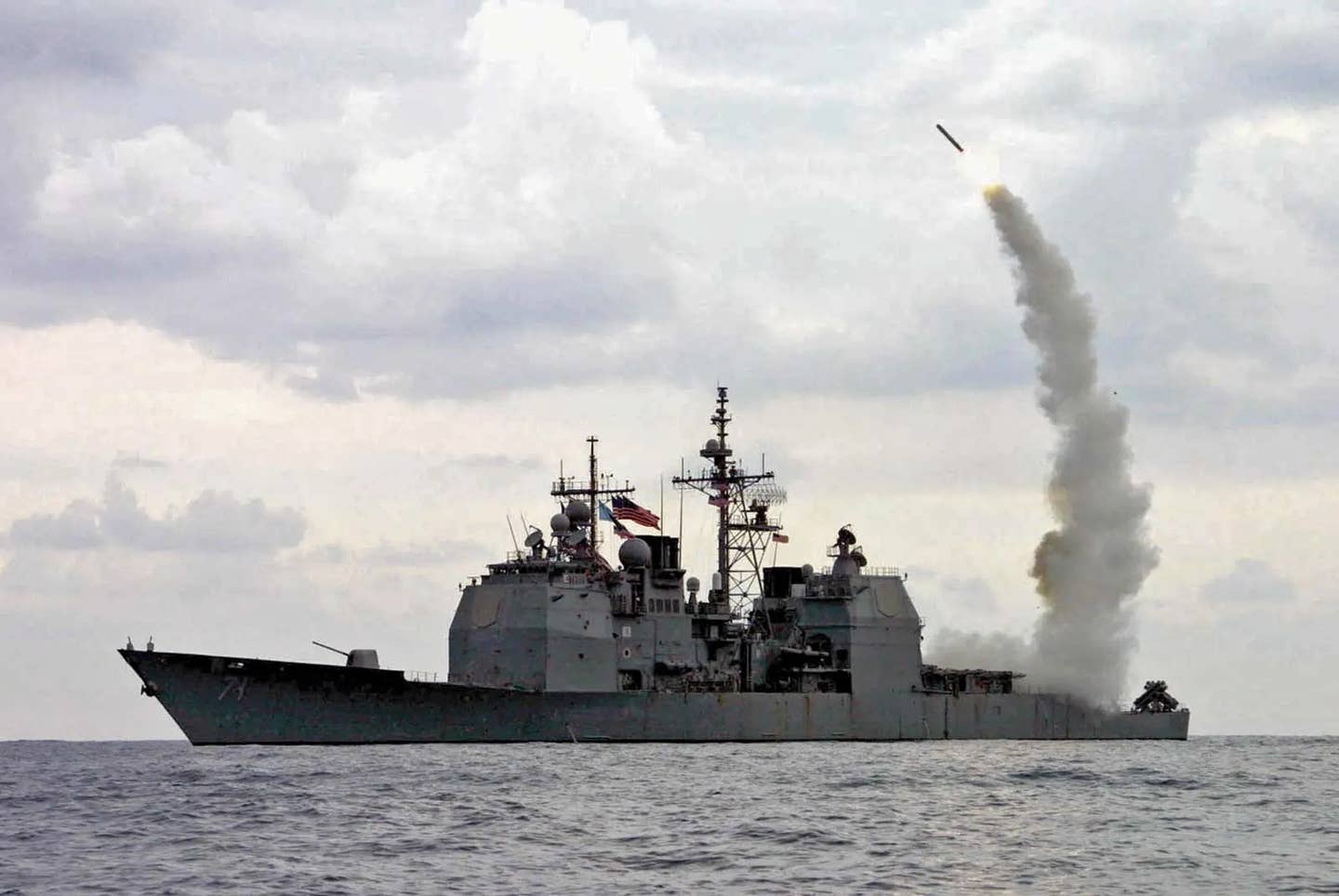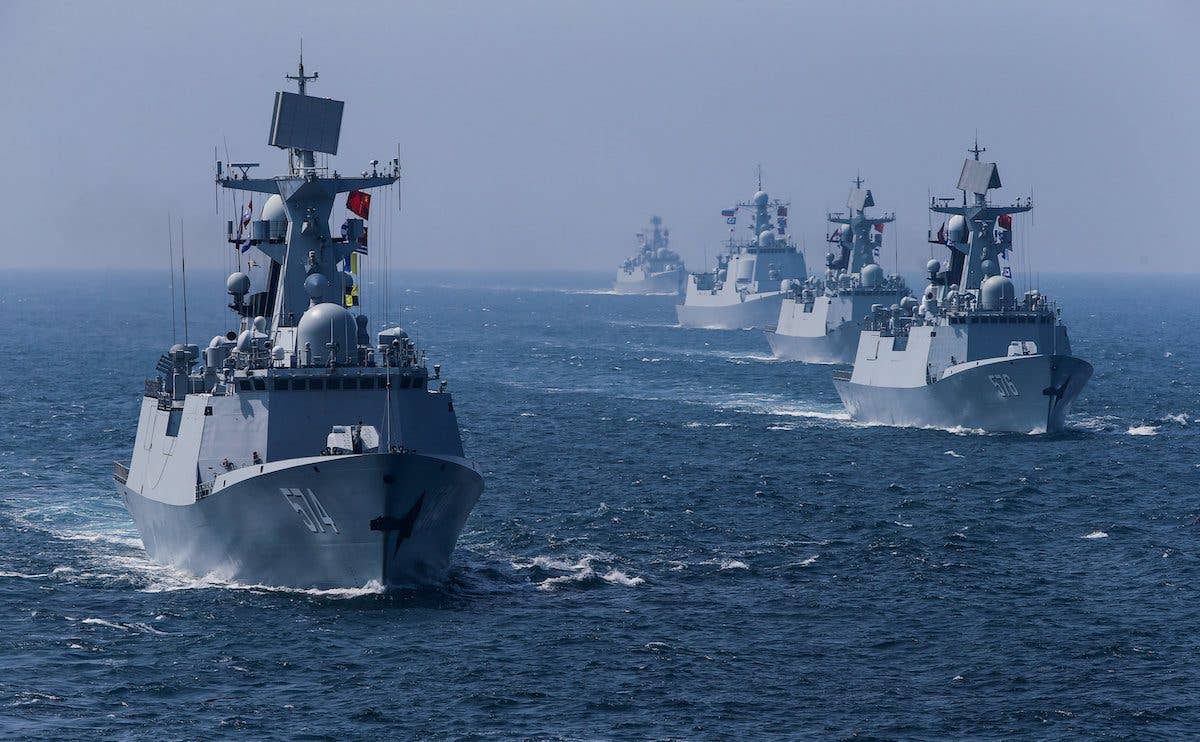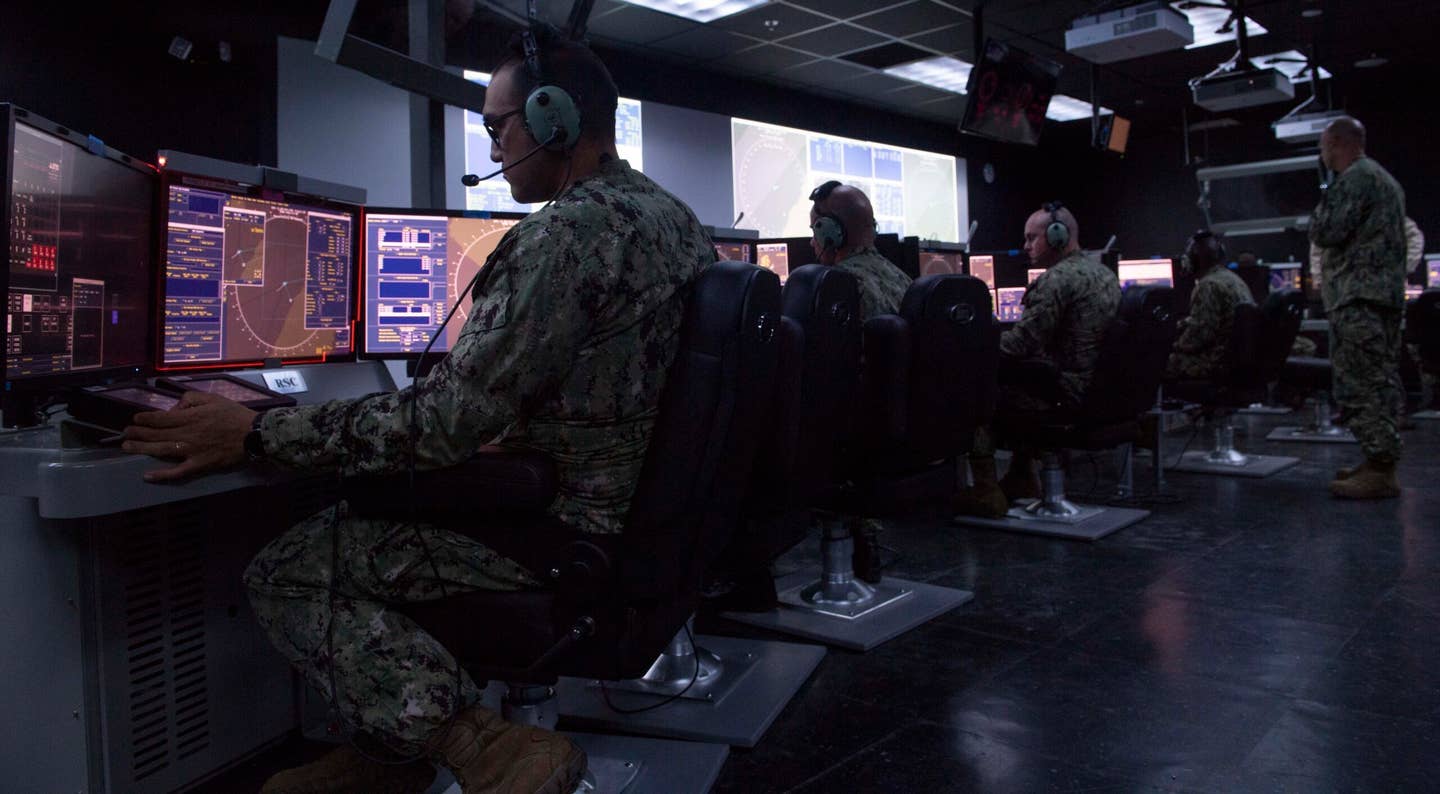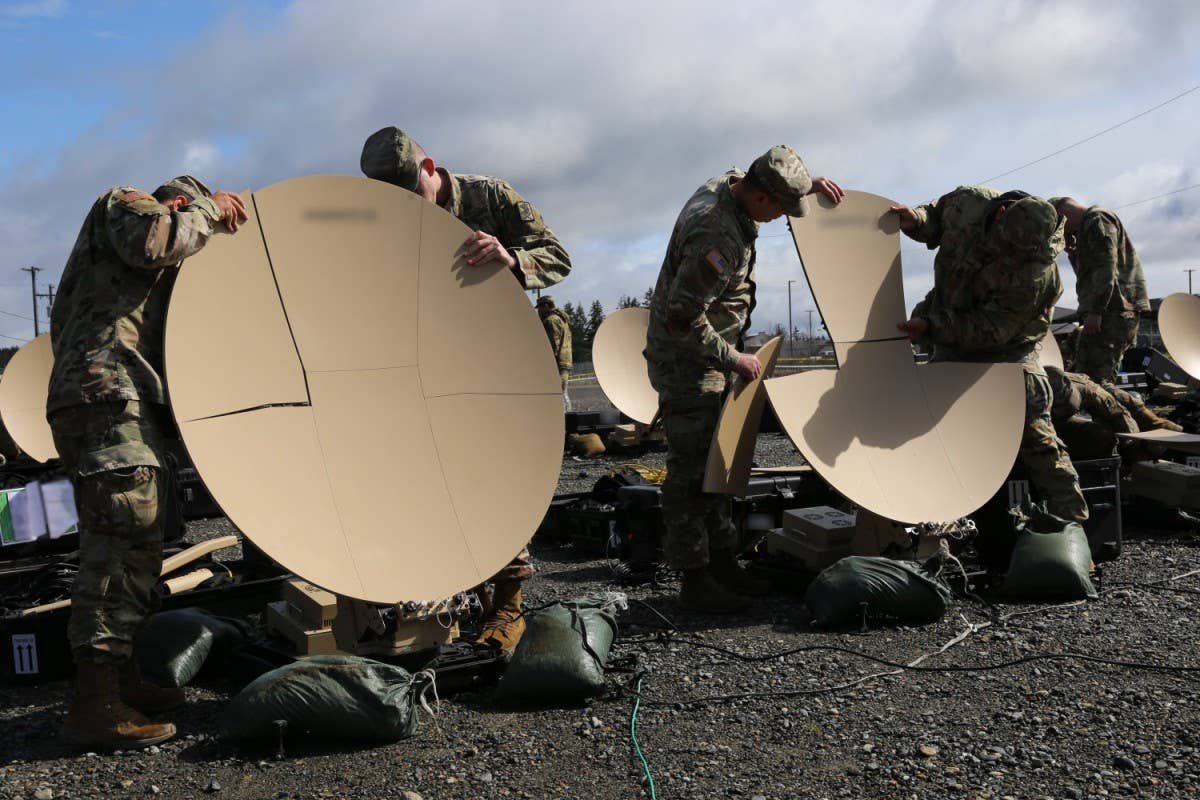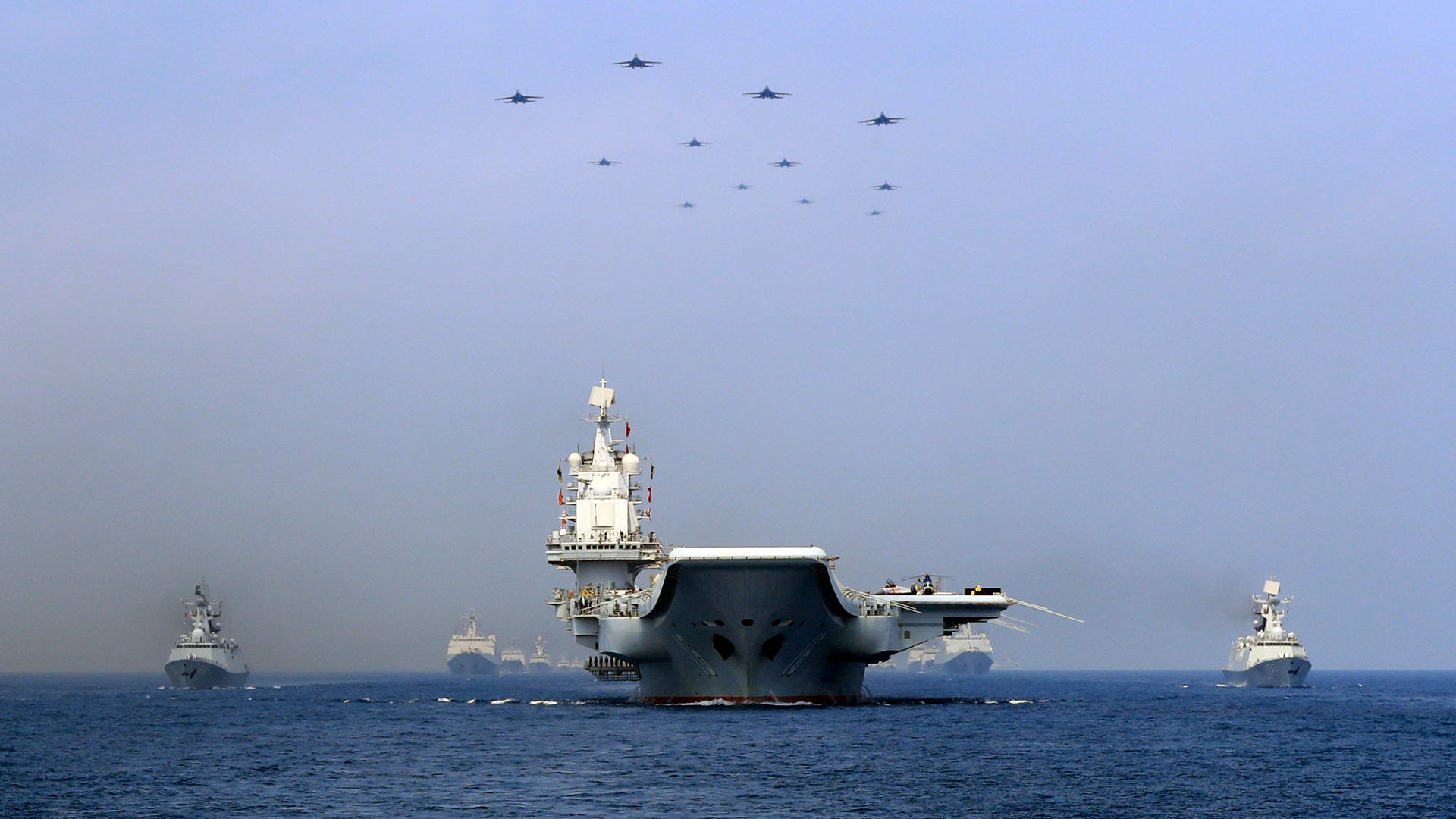Blind, See, Kill: The Grand Networking Plan To Take On China
A massive network is being constructed to give everyone from soldiers to allied countries a “single pane of glass” view of the battlefield.
BY
TYLER ROGOWAY|PUBLISHED AUG 29, 2023 6:56 PM EDT
THE WAR ZONE
PLAN
TYLER ROGOWAY
View Tyler Rogoway's Articles
Aviation_Intel
Admiral John Aquilino, commander of U.S. Indo-Pacific Command (INDOPACOM), offered remarkably detailed comments on what he sees as critical future capabilities needed to fight and win a high-end conflict in his vast area of responsibility — namely against China.
Aquilino's remarks came from the National Defense Industrial Association's Emerging Technologies and Defense symposium in Washington, D.C. yesterday, which
The War Zone attended. Joseph Dunford, a retired Marine four-star general and the ex-Chairman of the Joint Chiefs of Staff, hosted the discussion with the INDOPACOM boss.
Adm. John C. Aquilino, Commander of U.S. Indo-Pacific Command, has a very ambitious plan to connect all his forces and allies via a 'single pane of glass' interface. (U.S. Navy photo by Mass Communication Specialist 1st Class Anthony J. Rivera)
The talk quickly ventured into the topic of how Aquilino is preparing for what could become an unprecedented fight in terms of the speed and the scale that said capabilities will be applied over a vast battlefield. What's clear is that networking and data-fusion remain the centerpiece of America's emerging warfighting strategy in this tense region. At the center of the Admiral's plans is a grand networking scheme that ties everyone in the battlespace together — including regional allies — and offers a single 'pane of glass' God's eye view of the battlefield to everyone from soldiers on desolate windswept islands, to allied warships, to commanders managing the conflict thousands of miles away.
Author's note: Long quotes in a direct transcript fashion were used for this piece as there was no better way to properly convey the complex concepts the Admiral was putting forward, how they relate to one another, and the extra color that his own words could only provide.
"The approach for the United States military... is one piece of the forms of national power that are required, because the PRC [People's Republic of China] problem will require all forms of national power, and it's referred to as 'integrated deterrence' by the Secretary of Defense. I can speak about the military arm. Although we're coordinated with some of the other portions of national defense... our approach is to provide for lethal combat power west of the international dateline that's prepared to respond, that's postured accordingly, that is tied with our allies and partners, and has the right capabilities to be able to deter. And let there be no doubt the goal is to prevent this conflict, not to have it."
"That said, the Secretary gave me a second mission and says if deterrence has failed, then you better be prepared to fight and win... When we talk about the capabilities needed, we talk about it through the lens of 'blind, see, and kill...' The ability to operate in contested space survivably and deliver the effects that we're tasked to do, that's the 'blind' piece. The 'see' piece has to have a persistent understanding of the battlespace, where everything is at every second to a targeting level quality."
"Think, click, and shoot."
The
Ticonderoga class cruiser USS
Cape St. George launches a Tomahawk cruise missile. (USN)
"Then the kill piece is the right weapons with the right numbers of weapons, and the network that links them to be able to affect and close the kill chain. And my argument is all of my geographic combatant commander brothers and sisters want and need that same capability. We refer to it in the terms of 'decision superiority.' And that means first, we have it today, but we need to accelerate it and we need to always stay in front of any adversary."
Dunford then asked Aquilino about the challenges China is putting up to U.S. power projection, and what he feels better or worse about today than five years ago in terms of confronting and overcoming those challenges.
"What I think is they're on their five year [plan], and if you go back three different budgets for them, or four years, over our 20 years in the desert, they focused very clearly on delivering a force capable to take on the United States. And the speed and acceleration that they have shown and they are delivering, right, when you talk about outputs, we all look at the Chinese to understand, truly, where they are, what they're doing. The largest military buildup since World War Two, both in conventional forces and then strategic-nuclear. J-20s are in full-rate production,
ships coming off their industrial baseline at numbers that only replicate what we did in the Lehman time and the
600 ship Navy kind of time frame. Again,
nuclear build up... is the largest and continuous we've seen. So those are the concerning pieces. And that's what we're walking into."
The massive expansion of China's Navy is one of many concerns for U.S. commanders to deal with. (PLAN)
"Now, on the optimism side, the department focusing on the PRC as the primary security challenger and the defense strategy-based budget that has been pushed forward, certainly is encouraging. The deputy's words on the delivery of outcomes with speed [Deputy Secretary of Defense Hicks' speech earlier in the day which you can read more about
here] is encouraging..."
On how allies play into all this, Admiral Aquilino offered these words:
"As we all know, the key, or one of our asymmetric advantages, as we work through this delivery of deterrence is our synchronization, information sharing and work together with our allies and partners. Five treaty allies in the region: Japan, Korea, Philippines, Australia and Thailand. The work that we do together everyday, and it is every day with those allies, is critical — the partners as well [as] the rest of the nations in the region. What you have seen occur is more integration, more multilateral operations and rehearsals, and practice together. It is an asymmetric advantage that we have, whether we're talking about the trilateral relationship between Japan, Korea and the United States, recently described and emphasized by the heads of state. Whether you're talking about the support and the additional sites in the Philippines that we will build out and practice in order for our forces to be able to operate together. The work in
Australia with AUKUS tied with the United Kingdom to deliver once-in-a-generation warfighting capability, and then
expand from technology and other areas besides submarines, where we can deliver warfighting effects. Again, it's really an asymmetric advantage. And probably... one of the key opportunities that we have to continue exploiting."
"So let me get into a couple of programs now, because the development and the initiation of the programs I'll talk about... First, we talk about a Joint Fires Network. So when I articulate 'blind, see and kill,' the Joint Fires Network is the mechanism by which we would integrate, synchronize, and utilize to deliver effects anywhere in the battlespace, and bring to PACOM [INDOPACOM] — that's over half the globe. Whether they be fires, effects or logistics requirements, and synchronize those actions across the board. And those are applicable to be supported and delivered to our allies and partners as well."
Joint Fires Network will tie forces together via datalinks to provide a common actionable tactical picture. (U.S. Navy photo by Mass Communication Specialist 2nd Class Sonja Wickard/Released)
"Second, is a mission partner environment. Think of that as the transport mechanism to deliver and synchronize, integrate and operate with our allies and partners. Think of a 'single pane of glass' with the ability for login attributes, classification, and FTO requirements to be able to communicate with my partners anytime, anyplace, anyday."
"Third is referred to as the Pacific Multi-Domain Training And Experimentation Capability (PMTEC)... So think about linking
ranges from the west coast of the United States,
to Alaska, to Australia, to Guam, and to further forward in Japan, and anywhere in the theater. So, if you think about the ability to train together, over the broad space needed, and utilize that range as an experimentation capability with our allies and partners, now you get right after what the deputy was talking about, on how you practice, rehearse, experiment, and ultimately deliver capability."
"And then lastly, we work through what we refer to as Stormbreaker, which is our ability to run through scenarios, to develop CONOPS to assess those CONOPS and plan at a speed that can't be done today, without 'stubby pencil'
J5 planners, but to automate that set of capabilities."
Dunford then pushed for more info about the massive amounts of data and the processing, deconfliction, and display of that data under the 'Joint Data Integration Layer.' Dunford also noted that it is designed to overcome issues with interoperability and integration among disparate force elements.
"For us, it's the
Assault Breaker Two team that is plugged in on Hawaii. Matter of fact, they have put the virtual team and built a simulation facility in the Pacific for us to use this. Here's the metric for me, 1,000 targets in 24 hours — targeting level quality, persistent, ready to go. Now that's supported by many of the ISR [information, surveillance, and reconnaissance] assets... But really, what we're looking for is 'all source Intel' and the ability to distill it down to that wisdom we discussed. And boy, you're right, we still don't have enough ISR. But what I think this data-informed ability to pull it all together, you know, I go back to the aircraft shoot-down not long ago. And I think you were in the chair, right? How did we find out that the Russians actually shot that airplane down was by a social media post. We all have that data, because it all contributes. And then we have to weed through it to determine what's a value and how does it deliver to the fight."
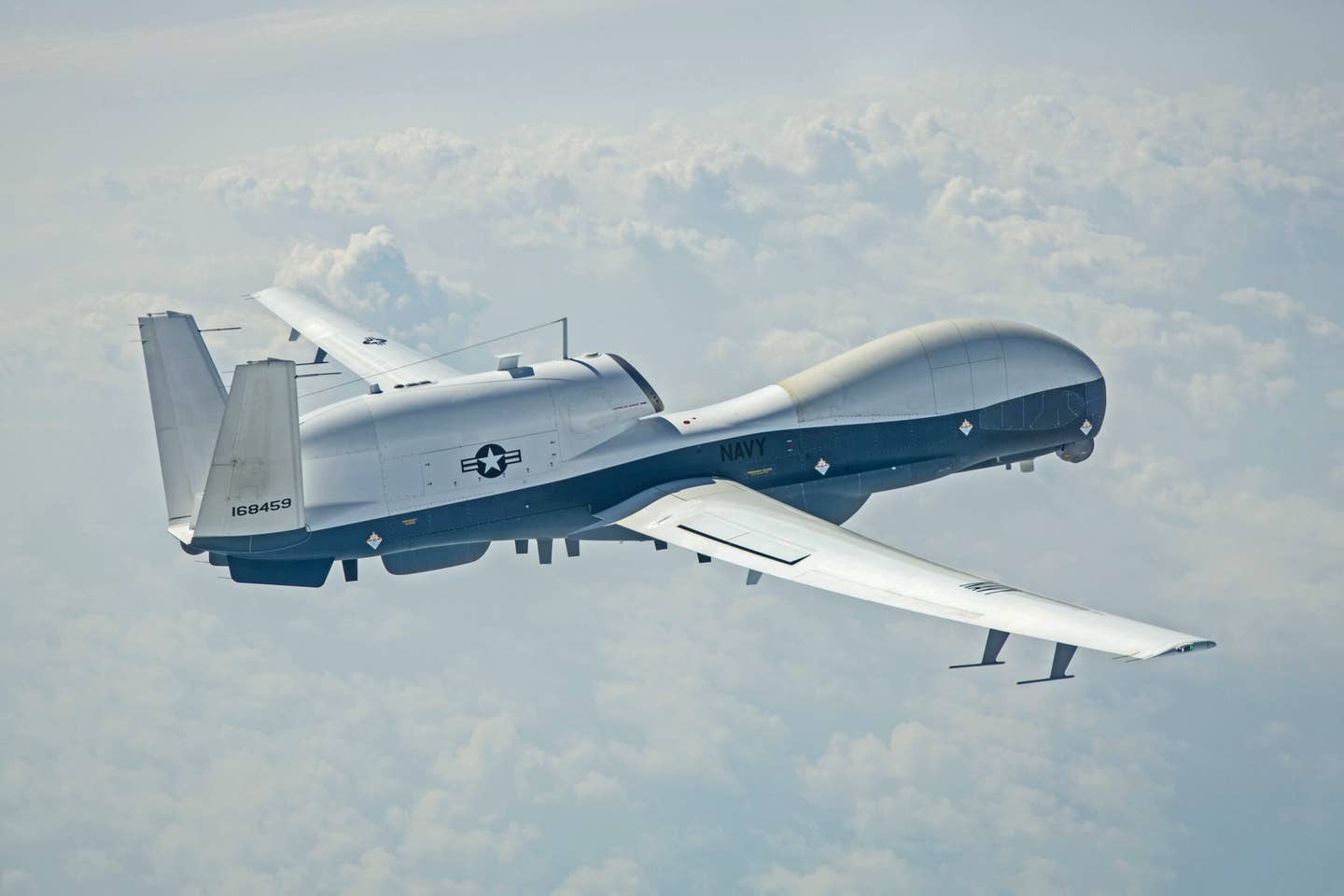
Under the Admiral's ambitious plan, everything will feed into a deconflicted and refined common battlespace picture, from high-end ISR assets like this MQ-4C Triton to a swarm of unmanned surface vessels to space-based sensing and even data collected by sensors that are forward-deployed by small ground units. The distributed nature of battlefield data collection will be critical to winning a future fight, but parsing and fuzing all of it and transferring it around a vast battlefield will be major hurdles. (USN)
Asking for more specificity as to the over-arching network that will enable what could only be defined as a revolution in connected warfighting, Aquilino gave this very clear summary:
"So from the INDOPACOM perspective, we are purely focused on the kill chain and the ability to persist, sustain, and command the fight. So think 'F2T2EA' — find, fix, target track, employ and assess. That is the foundational set of actions that have to occur from the military warfighting capability sense. Now on top of that, the approach is to be able to deliver a common operational picture for every node in the battlespace — the same exact targeting level quality picture for
everyone. And in that mesh node of delivery, any fighting formation is able to employ and carry out their responsibilities in the battlespace, whether there's an attempt to impact those command and control nodes. But that mesh allows it to occur. And again, the network that we're talking about, we refer to as the Joint Fires Network."
Project Manager Tactical Network, Program Executive Office for Command Control Communications-Tactical (PEO C3T), conducts Scalable Network Node (SNN) new equipment training for the 51st Expeditionary Signal Battalion (ESB) – converting the unit to a modernized ESB-Enhanced (ESB-E) formation – at Joint Base Lewis McChord, Washington. The SNN provides a significant reduction in the footprint requirements of an ESB-E. (Amy Walker, Project Manager Tactical Network, PEO C3T public affairs)
As to how very ambitious capabilities like the Joint Fires Network, and other emerging high-tech concepts, will go from great sounding ideas to operational realities
at scale, Aquilino said the following:
"In the Pacific, we certainly need to scale. Again, I don't know if I tie those two together the emerging technologies and scale. I think what I would say is the emerging technologies in our construction of the Joint Fires Network, Mission Partner Environment, PMTEC and Stormbreaker, I would view it through the lens of pulling those emerging technologies into the open architecture, in places where we provide benefit, and then deliver those capabilities. The scaling of it... when we did our first experiment with the Joint Fires Network, we started with a eight nodes — in
exercise Northern Edge Tac (sp?) One. In Northern Edge Tac Two we went up to 20 nodes. So, the key is to both inject emerging technologies that are advancing the capability, and then scaling it at a pace. So, I don't know if I tied the two together, but they certainly are interrelated and I just kind of gave you our approach on how to do this. And then in the next exercise-slash-experiment, we hope to increase that even more, and at some point, we'll pull in and plug one into one of our allies and partners. So the continued growth assessment on what was right, what was not right, and then [the] ability to adjust quickly. I think that's where it fits."
An F-117 aggressor recovers from a Northern Edge sortie, with Pantheon's 727 test jet and an B-1B in the background. Northern Edge is a critical set of test-focused war games that help prove emerging technologies and especially those surrounding networking. (USAF)
Finally, the Admiral offered more detail about what it will take, both in terms of diplomacy and technology, to get the U.S. and its regional allies all viewing the same battle 'picture' via advanced networking and communications:
"I think the first thing I would say is the sharing agreements across partner nations, right, all of our agreements are bilateral, and we're talking about a multinational way to link it. So we're gonna have to get to the agreements. We have to make sure that our partners trust that we will protect the things that are critical to them. We have to make sure that it's cyber-safe. We have to make sure that all of those nations understand what we're trying to do, how we're trying to do it, and how it betters the theater. So, the agreements piece is probably the longest pole."
"There are technology pieces that the team is working on... And oh, by the way, we've tried this before. The
CENTCOM partner network... 33 nations or so we're trying to get to a single pane of glass ability to synchronize, communicate, coordinate, organize and operate. Right now I have
16 separate networks to do that, and I can't get two of my buddies on the same piece of glass. So it's a huge challenge."
"Technologies is a piece, agreements are a piece, and with all the great work that my team and the department has done on the allies and partner side, we think we can move this pretty quickly too."
Contact the author: [email protected]
A massive network is being constructed to give everyone from soldiers to allied countries a "single pane of glass" view of the battlefield.

www.thedrive.com

www.politico.eu









